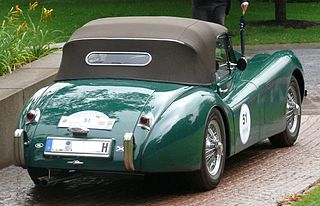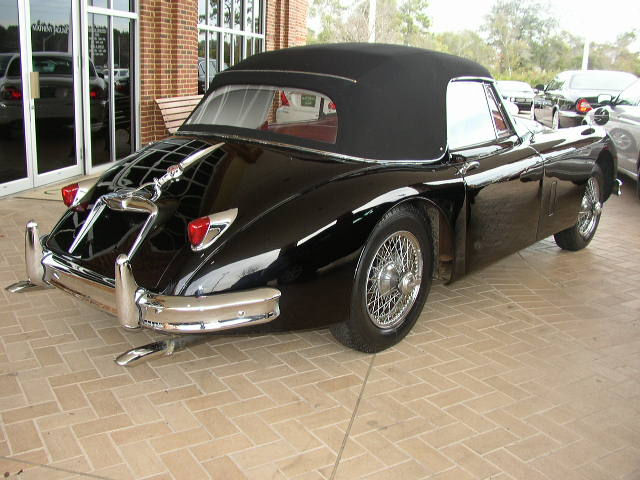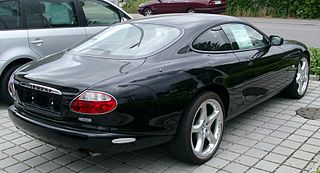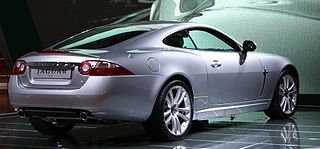Der Jaguar XK ist ein Sportwagen-Modell des Automobilherstellers Jaguar.
Modellgeschichte
1948 stellte Jaguar auf der London Motor Show einen neuen XK 120 genannten Sportwagen vor (XK stand für den Motor und 120 für die erreichbare Höchstgeschwindigkeit in Meilen).
Am 21. Juli 1949 wurde der erste XK 120 ausgeliefert. Im März 1951 wurde dem offenen Zweisitzer (OTS = Open Two Seater) ein Coupé mit festem Dach (FHC = Fixed Head Coupe) zur Seite gestellt. Im April 1953 wurde das Angebot um ein Coupé mit versenkbarem Stoffdach (DHC = Drop Head Coupe) erweitert. Bis zum Produktionsende im Herbst 1954 wurden 12.078 XK 120 (7.631 OTS, 2.678 FHC und 1.769 DHC) gebaut.
Im Oktober 1954 wurde auf der London Motor Show als Nachfolger der XK 140 mit leicht überarbeiteter Karosserie präsentiert.
Während der XK 120 vorne zwei zierliche Stoßfänger und hinten zwei Stoßstangenhörner hatte, bekam der XK 140 vorne eine massive, durchgehende Stoßstange und hinten zwei massive Stoßfänger. Der neue Kühlergrill hatte weniger, aber dafür dickere Rippen. FHC und DHC bekamen hinter den Sitzen zwei Notsitze und wurde so zum 2+2-Sitzer. Bis zum Produktionsende Anfang 1957 wurden 8.884 Exemplare gebaut.
Im Mai 1957 wurde der XK umfangreich überarbeitet und nun als XK 150 angeboten.
Eine einteilige Panoramawindschutzscheibe löste die zweiteilige Frontscheibe ab. Die Karosserie selbst war in alle Richtungen gewachsen und bot nun auch hinten eine durchgehende Stoßstange. Gegen Aufpreis konnte erstmals eine Jaguar-Kühlerfigur geordert werden. Bis zum Produktionsende wurden 9.395 Exemplare gebaut.
Zwischen 1949 und 1961 entstanden insgesamt 30.357 XK-Sportwagen, die wahlweise mit Scheibenrädern und Verkleidung der hinteren Radausschnitte (Spats) oder mit Speichenrädern erhältlich waren.
1996 belebte Jaguar die Modellbezeichnung XK wieder.
Zum 66-jährigen Jubiläum präsentiert Jaguar ein auf 66 Exemplare limitiertes Sondermodell Jaguar XK66 One of 66 als Reminiszenz an den XK120.
Die typischen Jaguar Farben British Racing Green und Stratus Grey, Leder in Caramel oder Warm Charcoal, Paneele in Walnusswurzelholz und poliertes Chrom werden als so genannter „Vintage Look“ umschrieben. Embleme mit „Union Jack“ und der Aufschrift „66“ am Heck und an den Seiten sowie „One of 66“ im Innenraum kennzeichnen die Limitierung auf nur 66 Exemplare. Die Preise belaufen sich auf 99.380,- Euro für das XK66 Coupé und 107.580,- EUR für das XK66 Cabriolet.
Dieser Artikel basiert auf dem Artikel Jaguar XK aus der freien Enzyklopädie Wikipedia und steht unter der GNU-Lizenz für freie Dokumentation. In der Wikipedia ist eine Liste der Autoren verfügbar.
Jaguar XK
The Jaguar XK series (XK, XK8 and XKR) is a series of grand tourer cars produced by British car maker Jaguar Cars since 1996. The series was introduced at the Geneva Motor Show on 5 March 1996, and the last car came off the production line on 23 July 2014. The first generation of the series, the XK8, replaced the XJS, and was available as a coupé and convertible. The XK8 was the first 8-cylinder vehicle produced by Jaguar since the Daimler 250, introducing the Jaguar AJ-V8 engine.The second generation XK was launched in 2006 (as a model year 2007). The new XK introduced an aluminium monocoque bodyshell, and is available both as a two-door coupé and two-door cabriolet/convertible, with just the engine and associated mechanicals being carried forward.
XK8/XKR (1996–2006)
The XK8 was launched in 1996 to replace the XJ-S. Two body styles were produced – a coupé and a convertible. The car was the first in the Jaguar line-up to use Jaguar’s newly developed V8 engine – the AJ-V8.[1] In 1998 the supercharged XKR was added to the range. However, both the XK8 and XKR are limited to a maximum top speed of 155.4 mph (250.1 km/h).
The XK8 came standard with 17-inch alloy wheels, while 18-inch (Standard on the XKR), 19-inch, and 20-inch wheels were available for the XK8 at an additional cost. Jaguar’s Adaptive Cruise Control is an optional feature available on both models. Both models came with all-leather interior, burl walnut trim, and side airbags. [2][3]
XK/XKR (2007–2014)
The newly designed XK was unveiled in 2005 at the Frankfurt Motor Show in Germany. Jaguar’s chief designer Ian Callum (who was also responsible for working on the Aston Martin DB7 and Vanquish coupés) claimed that the inspiration for the shape of the new XK came from his admiration for British actress Kate Winslet‘s curves.[4] The X150’s grille was also inspired from the famous 1961 Jaguar E-Type.[5]
The standard XK model has an unlimited top speed of 158 mph whilst the XKR an unlimited top speed of 174 mph. An even faster variant, the XKR-S model was introduced at the Geneva Motor Show in 2012. The XKR-S gained an additional 40-horsepower over the XKR bringing the 0-60 mph time down to only 4.4 seconds and the top speed up to 300 km/h (186 mph) – making it the fastest Jaguar yet after the Jaguar XJ220. A convertible version of the XKR-S was released in 2012.[6]
Production of the XK ceased in July 2014 without a replacement model until F-Type.
This article uses material from the Wikipedia article Jaguar XK, which is released under the Creative Commons Attribution-Share-Alike License 3.0 (view authors).











